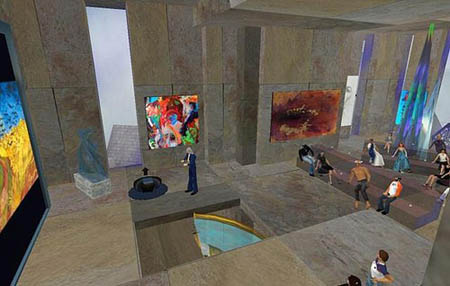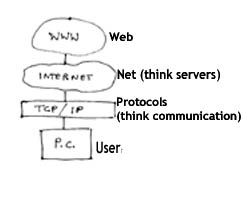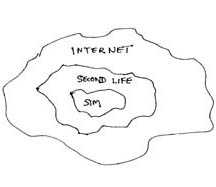Servers for the people! (picture from O’Reilly Radar)
Welcome to Net 0! Warana Unwired, a project from Microsoft Research India (see blog), bypasses Web 2.0, Web 3.0, Web 3D and Web(n+1) etc., etc. and puts the power of servers directly into the hands of the people, replacing pcs with cellphones. This may be the first project of its kind in developing regions “where an entire PC setup has been replaced with mobile phones.” Farmers can use the system to access “essential pieces of information such as the ideal time for planting and harvesting sugarcane, the current market rates of their produce, and payments made by the factories.”
But, as ifacethoughts points out, one big factor in the success of other projects is going to be “the Government regulations regarding this.” As, in terms of information access, the individual farmer is put on the same level as the giants. Also, Abhijit Nadgouda notes, Warana has better literacy rates, and more “industries and people there are aware of rest of the world.” In many places the most urgent need is to apply technology “to ease availability of energy, water, education and employment.”
(See Supercool School for a sneak peak at an “EduBlogger” event – “focusing on new and revolutionary ideas in education,” and, Neverwonderland for an interesting post on finding internet access solutions for rural Mexico. And, thanks Neil Caldwell for sending me the link to O’Reilly Radar. I am always interested to hear about how new ways to reach the superhighway are being pioneered on the dirt road.)
Reinventing the internet and the world wide web.
This story from rural India brings up an interesting and under discussed topic – the invisible layer beneath the visible World Wide Web, i.e., the Internet or Net. The terms Internet and World Wide Web are often used interchangeably but this is misleading and gets in the way of understanding all the ways both levels can be approached creatively.
Heres a little sketch in case you are confused!
The user interface of the future will not only bring smart searching, dubbed as Web 3.0, into the hyperlinked world of Web 2.O – social networks, user-Âcreated taxonomies of content, “and the kind interactivity, represented by sites such as Flickr, Del.icio.us, and Wikipedia.” It will also harness the multiple intelligences and multidimensionality of user generated virtual worlds like SL.
We can already see the beginning of this re-imagining in the current discussion around the future of Second Life. See, Information Week, and a very interesting article, “The Future of the Grid: How SL could cope with millions of concurrent users,” in The Avastar by Gwyneth Llewelyn. Gwyneth is a writer, mentor, artist, futurist, metathinker of Second Life and business manager of Beta Technologies.
Click here, for more about Gwyneth.
In her article, Gwyneth, discusses how LL [Linden Labs] can handle the ever increasing amount of users logging in to SL. She points out that what we understand as the Second Life grid today is “a collection of textures and prim data inside LL’s servers.” And, if LL were to allow “textures to be downloaded from outside the grid, perhaps even allowing users to store them on their own,” their 2000 servers would be able to handle 20 million simultaneous users.” (There is evidence Gwnyeth notes that, “the grid currently doesn’t handle well past 30K simultaneous users.”) But, she asks, if we start thinking of “the grid as just ‘the glue’ between SL clients and servers with no data…..what kind of service is LL providing then?”
People have speculated that Linden Labs will release the server source code as open source, (open source for the client was recently released), and LL has talked about moving more of Second Life to the Web, to reduce the burden on Second Life servers. Currently, “users can create accounts, check whether their Second Life friends are online, and buy and sell land and Linden Dollars using a Web browser (Information Week).” But, for Second Life to be a global interface much like the Web is today, it would have to go public domain, and to move out of the the current cozy nest (see diagram 1 below) to become a virtual reality interface that will replace the World Wide Web ( diagram 2 below).
As Second Life begins to take flight, the mind of Real Life and Second Life, is likely to become increasingly merged. The arrival of 3D voice in the coming months, heralds a new era when the “Second” aspect of Second Life will become more difficult to discern. There is some very interesting discussions on Augmentation vs Immersion (immersion puts the emphasis on the secondness) and what this means for advertising and branding on SL in Second Life Creativity. There will soon be more people on Second Life who have experienced it through voice than without. Friday night, I was fortunate to meet Gwyneth at an opening of the Museum of Contemporary Art in Neufreistadt. And, she pointed out that voice could well finish of those “pesky” immersionists once and for all! We talked a lot about the changes voice would bring to SL. Soon, “you will soon have 10 million users on Second Life that have only experienced SL through voice …….so who will care if 1 to 2 million people disagree and leave?” Eventually, you’d argue that “almost all those 10 million will come in because they ‘want’ more ‘RL in SL,’ not less, and voice is the best way to give them that…….and soon video mapping of your face on your avatar……”
The Second Life Herald, in a blast from the past, writes: “Conventional wisdom in Second Life suggests those who wish to import the real world into the metaverse are best served by tightly controlled private islands – particularly since many residents seem to prefer to separate second life and real life – and actively discourage RL incursions into their fantasy universe.” The ways things are going, Real Life infringements on Second Life are unlikely to be what is confined to private islands.

Golam Amadeus, master sculptor, gives an art lesson/seminar on the Museum of Contemporary Art in Neufreistadt. (photo by Gwyneth Llewelyn, Flickr)
Currently, some SL residents are extremely wary of the merging of RL with SL, worrying the loss of anonymity with the arrival of voice will mark the end of the creative fantasy worlds that been the heart and soul of Second Life up to now. After hearing peoples’ fears, about the way “old” cultures on Second Life will be affected by the coming of 3D voice, I have begun to wonder whether SL anthropologists and historians were already hurrying to the deep level fantasy communities and doing interviews and taking pictures of these soon to be “vanishing” cultures. Perhaps, these images will soon be part of a hip show at the MoCA examining their “constructednes.”
As well as talking to Gwyneth, about the future of SL, I did much of what I would do at a RL opening – check out some of the art and schmooze with press (yes, there were other bloggers and RL press there, including Aleister Kronos, Team Mascot, Redakisto Noble), artists, curators and other key influencers with drinks and hors d’oeuves in hand. Hey, its an art opening, I’m a New Yorker – this is not just Second Life its Second Nature!
And, when I was lucky enough to run into Gwyneth Llewelyn, I lost no time tapping into her deep understanding of the culture of SL. Gwyneth was at meetings in 2004 and 2005 hosted by Philip Linden when he said: “SL will never have voice, unless the technology evolves.” And, she noted, in 2006, he said, “we’re looking at some interesting technologies that will allow ‘voice’ to be as customizable as your avatar.” But, in the end, market pressures have brought 3D voice into Second Life without the kind of morphing technologies that would protect the anonymity that makes Second Life a second place, rather than an extension of Real Life. In 2007, he finally conceded that he was losing terrain to the competition. So, as Gwyneth pointed out, any new “3rd Life” or “After Life”, will have a window of perhaps 2-3 years. Then they will face the same issue.
“Voice is not just about ‘lack of anonymity,’ though; it is about a different conception of how a virtual world should work. I’m fairily confident that the ones relying on the lack of voice to protect their anonymity will not be the ones more affected (they are, as said, a small minority, of just a couple millions, which will fade out over the years). Instead, it will be the ones that will heavily use voice that will shape the ‘new’ Second Life, and it will be a quite different place, in the sense that old things that were possible only with chat will have to be done differently.”
I cannot, in this post, do justice to all the brilliant observations Gwyneth made on how voice would change the culture of Second Life. But, for a full analysis see her latest post, The Schism Around Voice: Multicasting vs. Broadcasting.” Second Life’s chat utility is a journalist’s dream delivering a full color coded transcript with a few clicks of the mouse. The transcript of our discussion is 24 pages long! Here is a little sample. Gwyneth is talking about the advantages of reading.
15:36] Gwyneth Llewelyn: A good example of this are the “news tickers” on the TV news… you know… they have became very popular in the past decade,
[15:36] Gwyneth Llewelyn: the advantage, of course, is that in a few seconds,
[15:36] Gwyneth Llewelyn: you can put all news there
[15:37] Gwyneth Llewelyn: and you don’t even need to have the sound on ![]()
[15:37] Gwyneth Llewelyn: so all TV stations do it that way
[15:37] Gwyneth Llewelyn: it’s not by “chance” or because it’s technologically more advanced,
[15:37] Gwyneth Llewelyn: but because you can convey much more information, much faster,
[15:37] Gwyneth Llewelyn: and people *do* have short attention spans
[15:38] Gwyneth Llewelyn: I give always the following example: every day people bombard me “oh, just listen to that podcast, it’s just 15 minutes and very interesting!”
[15:38] Gwyneth Llewelyn: my answer is: “sure — is there a text transcript of the podcast somewhere?”
[15:38] Gwyneth Llewelyn: Because that takes 1 minute to read,
[15:38] Gwyneth Llewelyn: and I can read 10 podcasts in the same minute, at the same time ![]()
[15:39] Gwyneth Llewelyn: While with ONE podcast that takes 15 minutes… i can’t do anything else!
[15:39] Gwyneth Llewelyn: It requires my full attention.
[15:39] Gwyneth Llewelyn: It’s *great* if I’m in the bath, though — LOL
[15:39] Gwyneth Llewelyn: or driving
[15:39] Tara5 Oh: yeah i know what you mean i was just thinking i was going to ask you if there was a way to save a chat history because this was a very interesting conversation and i missed half of it!
[15:39] Gwyneth Llewelyn: Oh, Ctrl-H, Tara
[15:40] Gwyneth Llewelyn: It pops up history, ie. the whole chat gets into a scrollable window
“Voice will kill multitasking, social events, and the uncanny ability of interacting with dozens (sometimes hundreds) of people *at the same time*. This, for me, is far more important than the “anonymity” aspect overall. It’s obvious that it’ll be far better for one-to-one communications (but why don’t people use Skype or even a phone for that?), short business meetings (which don’t require text transcripts), and, naturally, presentations, seminars, classes, conferences, announcements, live music events, and all sort of “broadcasting” events (one person talking, many listening). It’s of no use for “multicasting” events (all people talking, all listening). So SL will lose all of those slowly over time.
Does this worry me overall? Well, not really; “different” is not necessarily “bad”. But when thinking what tools like SL can give us — real-time multicasting ability — I’m sorry to see it go away. For me, it would be the same as having a new world-wide regulation that would require all bloggers to shut down their sites (which do allow asynchronous multicasting through comments) and register with public or private publishing companies that will provide them with broadcasting abilities, but no simultaneous feedback from their readers. I would certainly adapt, but also miss the joy of being a reader and an author at the same time — one of the most important things (or even “freedoms”) that the Web has given to us. SL has given us the ability to do that in real time, and now it removes it — so I’m obvious sorry to see it go away! I just hope that the creativity of using voice as a new geekish tool will compensate with new, interesting uses for that technology, that will give the “New Second Life” some new potential.”
I ended my last post on Second Life with Philip Rosedale‘s legendary proclamation, “I’m not building a game. I’m building a new country.†[interview to Wired, 2004-05-08] Which, Gwyneth notes, “received a serious blow when Linden Lab removed the telehubs. It was clear that what would follow next was a jump to private islands, where you can devise your own urban planning, and that there wouldn’t be “one countryâ€, but “several communities†inside the same virtual environment.” But, I will be following up on Aleister Kronos’s very interesting comments on this notion of Second Life as a country/countries, and what that means for laws and governance – Utopian Anarchy or Dystopian Chaos – in a another post. But, I am beginning to think Second Life is neither a game, nor a country. Rather, Second Life is about the reinvention of our world.
Tags: Second Life | Web 2.0 | Web 3.0 | Internet | Web 3D | Virtual Reality | Virtual Worlds | World Wide Web | Philip Linden | Philip Rosedale | Mulitcasting | Chat | Marketing | Voice Chat | IM Chat | global development | wireless networks | digital divides | Microsoft Research | |






March 26th, 2007 at 8:17 pm
What a great post! I never thought about the advantage of “no-audio” from that perspective – kudos to you for making me RETHINK some old perception…and thankx for mentioning Supercool School. Much power to you! Steli
March 27th, 2007 at 3:23 am
Hi Tish,
Once again you managed to cover an awful lot of ground in just one post!
My take on “voice” is that it is an essential new channel for SL, but that it is not mandatory to use it. I’ve voiced (hehe) this in responses on other blogs. IMHO, in situations needing rapid interaction, the push of information or when there is a low level of keyboard skills then voice will be the channel of choice. Mundane examples include: teaching classes; business presentations; client meetings etc. I’d note that, since voice meetings will not be “automatically minuted” (unlike chat/IM), it may prove necessary to employ a minute-taker.
What I like about chat (and IM) is its asynchronous nature. It may take time, but I can consider what I want to say more carefully. In a voice conversation I’d look pretty dumb if I was… well… dumb, so it is normal in voice to respond immediately. It also provides a natural barrier between my RL self and my SL self – I’m not sure that I want to immerse myself to the extent that I am talking in RL (and overheard by everyone around me), in order to be heard in SL.
Anyhoo… the most interesting area of impact is among the role-play communities in SL. Even with filters to tweak voice to match the avatar persona, role-play is suddenly reliant on good acting skills. Perhaps this will result in a partitioning of such communities into “role play leets”, who can actually act and will want to RP together, and “role play proles” who have to stick to chat to cover up their acting deficiencies.
In any event, “voice” is to be welcomed as an additional channel, augmenting what SL already has. It may prove seismic in its impact, as you suggest – but my view is that, for the near-term at least, it will be just another facility. It will also be interesting to see how a “voice etiquette” develops.
May 5th, 2007 at 3:57 am
Very good website you have here. I found it very interesting. safety hinge
lortab half life
Thank you.
May 19th, 2007 at 12:52 am
O, super project. Yes!
so hold.